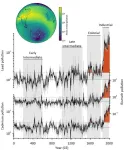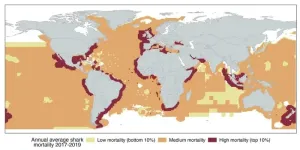(Press-News.org) New UC Davis research shows that men with an FMR1 premutation who experienced reduced executive function were at higher likelihood of developing fragile X-associated tremor/ataxia syndrome (FXTAS).
FXTAS is a progressive genetic condition that causes movement issues and cognitive decline. These findings, published in the journal Movement Disorders, could help clinicians determine which premutation carriers will eventually develop FXTAS.
“There's converging evidence that the premutation is affecting certain circuits in the brain before any movement problems show up on a clinical exam,” said the UC Davis MIND Institute’s David Hessl, a professor in the Department of Psychiatry and Behavioral Sciences, and the first author on the paper. “We’re getting closer to identifying the carriers who are most likely to develop full-blown FXTAS. If we could intervene early, we might be able to prevent it or slow it down significantly.”
Patients with FXTAS, which was first identified at the MIND Institute in 2001, experience cognitive decline and Parkinson’s disease-like movement issues. However, many people with FMR1 premutations do not go on to develop FXTAS. Hessl and colleagues have been investigating markers that might indicate which FMR1 carriers are at highest risk.
Executive function as a marker
For many years, the MIND Institute has been studying people with FMR1 variations to better understand the natural history of FXTAS. In this most recent study, the team followed 66 people with FMR1 premutations, and 31 controls, for up to nine years. During follow-up visits, participants and their partners completed executive function inventories and other assessments to measure the carriers’ function.
“Executive function refers to the cognitive abilities that help us organize our behavior: to resist impulses, be patient and not jump into things too quickly,” Hessl said. “They also regulate our attention and working memory, so holding information in our mind while we're doing something else. For example, remembering where you put your phone after you’ve gone on to do something else.”
When the study started, premutation carriers’ executive function was similar to controls. But over time, a significant number of FMR1 carriers developed executive function challenges. Overall, the results showed that carriers who experienced problems with working memory, organization, task monitoring and other traits were more likely to develop FXTAS.
“It’s one of the earliest indicators we've been able to identify that has some predictive value for who would develop FXTAS later,” Hessl said. “We don't have enough data to know how strong of a predictor it is, but it did significantly associate with later conversion, which was eye-opening.”
The authors caution that this is just one step in a long journey to develop precise clinical tools to identify which patients will develop FXTAS. While the findings in this study were statistically significant, they do not indicate the marker’s clinical precision.
“It doesn't tell us whether a patient with X amount of executive function change has double the risk, five times the risk, or 10 times,” Hessl explained. “We don't yet know how strong these predictors are, and we want to build models that will tell us that.”
Still, this new understanding could help clinicians better monitor their FMR1 carriers. And while there are no current FXTAS treatments, there are drugs being tested, and monitoring executive function could be useful in determining their efficacy.
“We're looking at a number of different markers associated with disease progression,” Hessl explained. “These include behavioral issues, like executive function, molecular biomarkers and data from brain MRIs. We believe there may be combinations of risk factors that could be examined in concert. There may be emerging machine learning and other statistical approaches that could combine these and help us achieve much better predictions, tell us who is at higher risk, or even identify protective factors.”
Co-authors on the study include Karina Mandujano Rojas, Emilio Ferrer, Glenda Espinal, Jessica Famula, Andrea Schneider, Randi Hagerman and Flora Tassone of UC Davis, and Susan Rivera of the University of Maryland.
This research was funded by the National Institute of Neurological Diseases and Stroke (NS110100), and the National Institute of Child Health and Human Development (HD036071, P50HD103526).
END
Loss of executive function may signal onset of neurodegenerative condition FXTAS
New findings may support clinical trials and earlier treatment for fragile X-associated tremor/ataxia syndrome
2024-01-11
ELSE PRESS RELEASES FROM THIS DATE:
The first assessment of toxic heavy metal pollution in the Southern Hemisphere over the last 2,000 years
2024-01-11
Human activity, from burning fossil fuels and fireplaces to the contaminated dust produced by mining, alters Earth’s atmosphere in countless ways. Records of these impacts over time are preserved in everlasting polar ice that serves as a sort of time capsule, allowing scientists and historians to link Earth’s history with that of human societies. In a new study, ice cores from Antartica show that lead and other toxic heavy metals linked to mining activities polluted the Southern Hemisphere as early as the 13th century.
“Seeing evidence that early Andean ...
Bulky additives could make cheaper solar cells last longer
2024-01-11
Images
An insight into preventing perovskite semiconductors from degrading quickly, discovered at the University of Michigan, could help enable solar cells estimated to be two to four times cheaper than today's thin-film solar panels.
Perovskites may also be combined with the silicon-based semiconductors that are prevalent in today's solar panels to create "tandem" solar cells that could surpass the maximum theoretical efficiency of silicon solar cells.
"Silicon solar cells are great because they are very efficient and can last for a very long time, but the high efficiency comes with a high cost," ...
A global study reveals pathways to save threatened sharks, despite rising mortality trends
2024-01-11
Sharks have persisted as powerful ocean predators for more than 400 million years. They survived five mass extinctions, diversifying into an amazing variety of forms and lifestyles. But this ancient lineage is now among the world's most threatened species groups due to overexploitation in poorly regulated fisheries and the proliferation of wasteful finning practices.
Governments around the world have introduced a host of regulations aimed at reducing shark catch and finning, the latter of which typically sees valuable shark fins retained for sale while carcasses are discarded at sea. But until ...
Discovered in the Upper Amazon: 2500-year-old landscape providing evidence for early urbanism in the region
2024-01-11
A dense system of pre-Hispanic urban centers, characterized by constructed platforms and plazas and connected by large, straight roads, has been discovered in the upper Amazon, according to a new study. The research, based on more than 20 years of interdisciplinary research, suggests that this original 2500-year-old society constitutes the earliest and largest low-density agrarian urbanism documented in the Amazon thus far. Such extensive early development in the Upper Amazon resembles similar Maya urban systems in Central America. ...
Machine learning clinical prediction models fail to generalize across trial data
2024-01-11
Clinical prediction models for schizophrenia treatment outcomes that work well within the trials from which they were developed fail to generalize to future trials, according to a new study. “The findings not only highlight the necessity for more stringent methodological standards for machine learning approaches but also require reexamination of the practical challenges that precision medicine is facing,” writes Frederike Petzschner in a related Perspective. Despite receiving the same treatments for the same afflictions, some patients get better while others show no improvement. Precision medicine approaches seek to address this problem by providing tailored treatments for individual ...
Shark fishing mortality on the rise despite regulatory change
2024-01-11
Despite widespread legislation and fishing regulations aimed at reducing wasteful shark finning practices, global shark fishing mortality is still on the rise, researchers report. The findings suggest that improved regulations are needed to reverse the continued overexploitation of these species. Over the last several decades, sharks have been increasingly recognized as some of the planet’s most threatened wildlife. Increasing shark mortality has been driven in part by overfishing – large numbers of sharks are often captured as bycatch in tuna ...
Comprehensive assessment reveals high extinction risks for thousands of Atlantic Forest trees in eastern South America
2024-01-11
A comprehensive analysis of tree species’ conservation statuses across Atlantic Forest trees reveals high extinction risks. According to the report, roughly two-thirds of the 4950 tree species living in this biodiversity hotspot are threatened with extinction. This includes 82% of endemic species, which have quite limited geographic ranges. Based on these findings, the authors suggest that the conservation status of tropical forests worldwide may be worse than previously believed. Conservation efforts and decisions often ...
Lab-grown retinas explain why people see colors dogs can’t
2024-01-11
With human retinas grown in a petri dish, researchers discovered how an offshoot of vitamin A generates the specialized cells that enable people to see millions of colors, an ability that dogs, cats, and other mammals do not possess.
“These retinal organoids allowed us for the first time to study this very human-specific trait,” said author Robert Johnston, an associate professor of biology. “It’s a huge question about what makes us human, what makes us different.”
The findings, published in PLOS Biology, increase understanding of color ...
KAUST scientists unveil blueprint for affordable solar cells to power Saudi Arabia and beyond
2024-01-11
Thuwal, Saudi Arabia, Month Day, Year – Scientists at King Abdullah University of Science and Technology (KAUST) have unveiled a roadmap for bringing perovskite/silicon tandem solar cells to market, paving the way for a future powered by abundant, inexpensive clean energy in Saudi Arabia and the world.
The authors of the article, published in esteemed journal Science, include Prof. Stefaan De Wolf and his research team at the KAUST Solar Center.
The team is working on improving solar efficiency to meet Saudi Arabia’ solar targets.
Perovskite/silicon tandem technology combines the strengths of two materials – perovskite's efficient ...
Quest for personalized medicine hits a snag
2024-01-11
New Haven, Conn. — The quest for personalized medicine, a medical approach in which practitioners use a patient’s unique genetic profile to tailor individual treatment, has emerged as a critical goal in the health care sector. But a new Yale-led study shows that the mathematical models currently available to predict treatments have limited effectiveness.
In an analysis of clinical trials for multiple schizophrenia treatments, the researchers found that the mathematical algorithms were able to predict patient outcomes within the specific ...
LAST 30 PRESS RELEASES:
Securing AI systems against growing cybersecurity threats
Longest observation of an active solar region
Why nail-biting, procrastination and other self-sabotaging behaviors are rooted in survival instincts
Regional variations in mechanical properties of porcine leptomeninges
Artificial empathy in therapy and healthcare: advancements in interpersonal interaction technologies
Why some brains switch gears more efficiently than others
UVA’s Jundong Li wins ICDM’S 2025 Tao Li Award for data mining, machine learning
UVA’s low-power, high-performance computer power player Mircea Stan earns National Academy of Inventors fellowship
Not playing by the rules: USU researcher explores filamentous algae dynamics in rivers
Do our body clocks influence our risk of dementia?
Anthropologists offer new evidence of bipedalism in long-debated fossil discovery
Safer receipt paper from wood
Dosage-sensitive genes suggest no whole-genome duplications in ancestral angiosperm
First ancient human herpesvirus genomes document their deep history with humans
Why Some Bacteria Survive Antibiotics and How to Stop Them - New study reveals that bacteria can survive antibiotic treatment through two fundamentally different “shutdown modes”
UCLA study links scar healing to dangerous placenta condition
CHANGE-seq-BE finds off-target changes in the genome from base editors
The Journal of Nuclear Medicine Ahead-of-Print Tip Sheet: January 2, 2026
Delayed or absent first dose of measles, mumps, and rubella vaccination
Trends in US preterm birth rates by household income and race and ethnicity
Study identifies potential biomarker linked to progression and brain inflammation in multiple sclerosis
Many mothers in Norway do not show up for postnatal check-ups
Researchers want to find out why quick clay is so unstable
Superradiant spins show teamwork at the quantum scale
Cleveland Clinic Research links tumor bacteria to immunotherapy resistance in head and neck cancer
First Editorial of 2026: Resisting AI slop
Joint ground- and space-based observations reveal Saturn-mass rogue planet
Inheritable genetic variant offers protection against blood cancer risk and progression
Pigs settled Pacific islands alongside early human voyagers
A Coral reef’s daily pulse reshapes microbes in surrounding waters
[Press-News.org] Loss of executive function may signal onset of neurodegenerative condition FXTASNew findings may support clinical trials and earlier treatment for fragile X-associated tremor/ataxia syndrome



